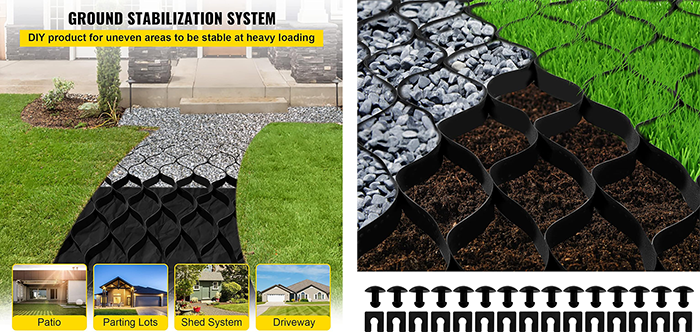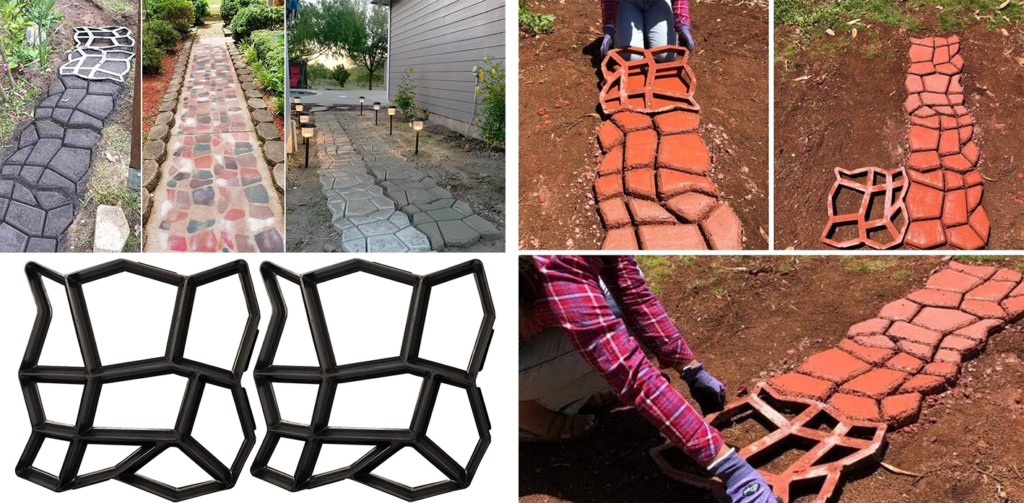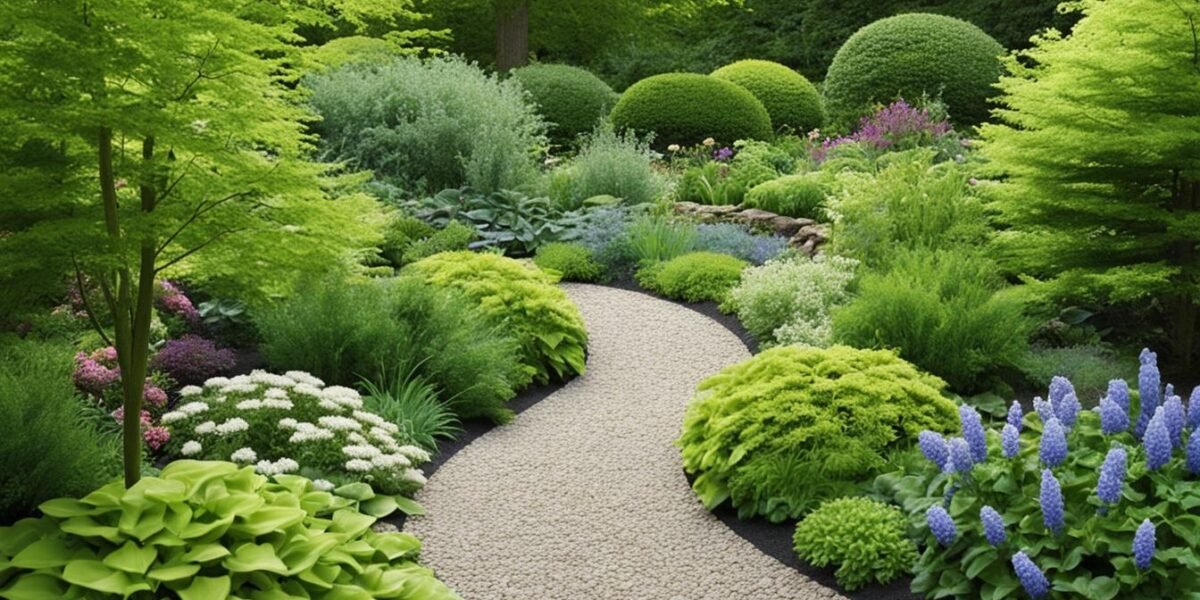Welcome to my simple guide on creating garden pathways . Whether you have a sprawling backyard or a compact urban oasis, adding pathways to your garden can transform it into a charming and functional outdoor space. In this article, I will walk you through different materials and methods for creating beautiful garden pathways.
Are you ready to embark on a journey to enhance the beauty and functionality of your outdoor oasis? Let’s dive in and explore the world of garden pathways!
Whether you envision a winding stone path through lush greenery or a gravel walkway that complements your colorful flower beds, the possibilities are endless. Creating pathways not only adds visual appeal but also improves accessibility and directs the flow of movement within your garden.
Throughout this simple guide of Garden Pathways, we will discuss various options, from materials like gravel, pavers, wood mulch, and stones, to low-maintenance techniques, affordable DIY ideas, and a step-by-step path creation process.
By the end of this article, you will be equipped with the knowledge and inspiration to create stunning garden pathways that enhance the overall beauty and functionality of your outdoor space. Let’s get started on your journey towards a more inviting and captivating garden!
Table of Contents
Choosing the Right Garden Path Material
When it comes to creating a garden path, choosing the right material is crucial for both functionality and aesthetics. There are various options available, each with its own pros and cons. Let’s explore some popular Garden Pathway materials:
Gravel Paths
Gravel paths are a popular choice due to their affordability and versatility. They provide a rustic look and are easy to install. However, they may require occasional maintenance as the gravel can shift or scatter over time.
You can use the Ground that hold gravel in place, preventing the migration of the top layer of gravel laterally (sideways) as well as down into the gravel base or subgrade. Rutting is prevented as a result. These benefits lead to longer-lasting surfaces and lower maintenance costs.

Turf Paths
Turf paths offer a lush and eco-friendly option. They create a seamless blend with the surrounding garden and provide a soft surface to walk on. However, they may require regular mowing and can be less durable compared to other materials.

Paver Paths
Paver paths are a versatile choice that can complement various garden styles. They come in various shapes, sizes, and colors, allowing for endless design possibilities. Pavers offer durability and low maintenance, but they can be more expensive compared to other options.

Mortared Paths
Mortared paths provide a solid and permanent solution. They are made by setting stones or bricks in a mortar bed, resulting in a stable surface. Mortared paths offer longevity and can withstand heavy foot traffic, but they require professional installation and can be more costly.
Wood Paths
These natural walkways offer a timeless appeal, weaving through vibrant blooms and lush greenery. With each step, experience a sensory journey, the gentle creak of wood underfoot, and the earthy scent of the forest beckoning you forward

Wood Mulch Paths
Wood mulch paths create a natural and organic feel. They are easy to install and provide a soft surface. However, they may require regular replenishing as the mulch can decompose over time. Additionally, wood mulch paths may not be suitable for areas with heavy rainfall.

Stone Paths
Stone paths add a touch of elegance and timeless beauty to your garden. They come in various shapes, sizes, and textures, allowing for customized designs. Stone paths are durable and low maintenance, but they can be more expensive and require professional installation.
When choosing the right path material, consider factors such as cost, maintenance requirements, durability, and the overall aesthetic appeal that aligns with your garden style.

| Path Material | Pros | Cons |
|---|---|---|
| Gravel Paths | Affordable, versatile | May require maintenance, can shift over time |
| Turf Paths | Lush, eco-friendly | Regular maintenance, less durable |
| Paver Paths | Endless design possibilities, durable | Higher cost, professional installation |
| Mortared Paths | Stable surface, longevity | Professional installation, higher cost |
| Wood Mulch Paths | Natural feel, soft surface | Regular replenishing, may not be suitable for heavy rainfall |
| Stone Paths | Elegant, durable | Higher cost, professional installation |
Tips for Creating Low-Maintenance Paths
If you want to create low-maintenance garden paths, there are a few tips to keep in mind:
- Start with a solid base: The foundation of any successful garden path is a solid and well-drained base. To achieve this, consider using materials like sand or gravel to provide stability and prevent erosion. A good base will ensure that your path stays intact and requires minimal maintenance.
- Add a formal edge: Surrounding your path with a formal edge is essential for maintaining its structure and preventing shifting. Whether it’s using bricks, stones, or metal edging, a formal edge will keep your path in place and give it a polished look.
- Consider good drainage: Opt for materials that promote good drainage, such as permeable pavers or gravel. This will prevent water from pooling on the surface of your path, reducing the risk of damage and making maintenance easier.
- Choose materials with minimal maintenance requirements: When selecting materials for your paths, prioritize those that require little to no maintenance. Options like concrete pavers or natural stone can be durable and long-lasting, requiring only occasional cleaning or repair.
By following these tips, you can create low-maintenance garden paths that not only enhance the beauty of your outdoor space but also minimize the time and effort needed for upkeep.

Benefits of Low-Maintenance Paths
Investing in low-maintenance garden pathway offers several advantages:
- Time-saving: With minimal maintenance requirements, low-maintenance paths save you valuable time and effort. You can spend more time enjoying your garden instead of constantly tending to its pathways.
- Cost-effective: Low-maintenance materials often have a longer lifespan, reducing the need for frequent replacements or repairs. This can save you money in the long run and provide a better return on your investment.
- Enhanced durability: By choosing materials with good drainage and a solid base, your paths are less likely to develop cracks or other damage over time. This ensures the longevity of your pathways, minimizing the need for extensive repairs.
- Aesthetically pleasing: Low-maintenance Garden Pathway can still be visually appealing and complement the overall design of your garden. You can choose from a variety of materials and styles that suit your personal taste and enhance the beauty of your outdoor space.
Creating low-maintenance garden paths requires thoughtful planning and careful consideration of materials and techniques. By implementing these tips, you can enjoy beautiful pathways that require minimal upkeep, allowing you to fully immerse yourself in the tranquility and beauty of your garden.
Affordable DIY Path Ideas
If you’re searching for affordable Garden Pathway ideas, look no further! Creating beautiful pathways in your garden doesn’t have to break the bank. With a touch of creativity and some affordable materials, you can transform your outdoor space into a charming retreat.
Informal Paths for a Timeless Look
Informal paths offer a casual and relaxed feel, perfect for creating a charming garden atmosphere. They effortlessly blend into the surrounding landscape, providing a seamless transition between different elements of your garden.
One popular choice for informal paths is using rocks. Rocks come in various shapes, sizes, and colors, allowing you to create unique and eye-catching walkways. Arrange them in a way that feels natural, perhaps leading to a hidden garden nook or a peaceful pond. The irregularity of rock walkways adds a touch of rustic elegance to your garden.

Casual Garden Paths on a Budget
Another budget-friendly option for your garden paths is using organic materials like mulch and gravel. Mulch paths offer a natural and earthy look, while gravel paths provide a charming crunch underfoot.
To create a mulch path, choose from a variety of wood chips, such as cedar or cypress, which not only look beautiful but also help with weed control and moisture retention. Spread a layer of mulch around 2-3 inches thick, ensuring it covers the entire path. This low-cost and easy-to-maintain option adds a cozy and inviting feel to your garden.
Gravel paths are another fantastic choice for casual garden paths. The texture and sound of gravel underfoot create a relaxing and soothing walking experience. Gravel is available in different colors and sizes, allowing you to customize your path to match your garden’s aesthetic. With proper edging, gravel paths can stay in place and require minimal maintenance.
Walkway Materials Comparison
| Material | Pros | Cons |
|---|---|---|
| Rocks | Unique and timeless look | Requires careful placement and leveling |
| Mulch | Natural and cozy feel | May need occasional replenishing |
| Gravel | Relaxing and soothing walking experience | May need periodic regrading |
As you can see from the table above, each material has its advantages and considerations. Choose the one that best fits your budget, desired aesthetic, and maintenance requirements.
With these affordable DIY path ideas, you can create stunning garden pathways without breaking the bank. Let your creativity flow, and enjoy the beauty and functionality that these casual and affordable paths bring to your outdoor oasis.
Step-by-Step Path Creation Process
Creating garden paths is a step-by-step process that ensures you achieve beautiful, low-maintenance paths that add charm to your outdoor oasis. Let’s dive into the path creation process:
1. Prepare the Area
Start by clearing the area where you want to create the path. Remove any existing vegetation, rocks, or debris. This will provide a clean canvas for your pathway.
2. Lay Newspapers or Cardboard
To prevent weeds from growing through your path, lay newspapers or cardboard as a weed barrier. This will help to smother any existing vegetation and prevent weed growth.
3. Install Landscaping Fabric
After laying the weed barrier, install landscaping fabric on top. The fabric will further inhibit weed growth and act as a stabilizer to hold the path materials in place.
4. Spread Woodchips
Once the landscaping fabric is in place, spread a layer of woodchips on top. Woodchips are a popular choice for creating low-maintenance paths as they require minimal upkeep and provide a natural aesthetic.
5. Add Path Edging
To give your path a clean and defined look, consider adding path edging. This can be done using materials such as stones, bricks, or metal strips. Edging will help keep the woodchips in place and create a tidy border for your pathway.
6. Maintain Your Path
Regular maintenance is key to ensuring the longevity of your garden path. Check for any areas where the woodchips may have thinned or shifted and top-up as needed. Additionally, remove any weeds or debris that may accumulate on the path over time.
| Materials | Pros | Cons |
|---|---|---|
| Woodchips | – Low-maintenance | – May decompose over time |
| Landscaping Fabric | – Blocks weed growth | – Requires careful installation |
| Newspapers/Cardboard | – Effective weed barrier | – May degrade over time |
| Path Edging | – Provides clean finish | – Requires additional installation |
Conclusion
Creating pathways for your garden is a surefire way to enhance both its beauty and functionality. By carefully choosing the right materials and implementing low-maintenance techniques, you can transform your landscape into a true outdoor oasis. Whether you prefer the natural charm of gravel paths, the elegance of paver paths, or the rustic appeal of wood mulch paths, there are endless garden path inspiration ideas to explore.
One of the key benefits of incorporating low-maintenance landscaping into your garden pathways is the ability to enjoy outdoor beauty without the hassle of constant upkeep. By following a step-by-step process that includes proper base preparation, effective weed control, and thoughtful path edging, you can create stunning pathways that require minimal maintenance.
So, get inspired by the wide range of garden path ideas available and start transforming your outdoor space into a low-maintenance paradise. With the right materials and techniques, you can create pathways that not only add charm and functionality but also allow you to truly enjoy the beauty of your garden. Let your garden pathways be a reflection of your personal style and create an inviting atmosphere for you and your guests to wander through with delight.
FAQ : Garden Pathway
Can you provide a simple guide for creating pathways for my garden?
Yes, creating pathways for your garden can add charm and functionality to your outdoor oasis. In this simple guide, we will explore different materials and methods for creating garden pathways.
What are the popular material options for Garden Pathways?
Some popular choices for garden path materials include gravel, turf, pavers, mortared paths, wood mulch, and stones. Each material has its pros and cons, considering factors such as cost, maintenance requirements, and aesthetic appeal.
How can I create low-maintenance garden paths?
To create low-maintenance garden paths, you can follow a few tips such as ensuring a solid, well-drained base using materials like sand or gravel, surrounding pavers with a formal edge to prevent shifting, and selecting materials with good drainage and minimal maintenance requirements.
Are there any affordable DIY path ideas for my garden?
Yes, there are plenty of affordable DIY path ideas to choose from. Informal paths and casual garden paths can blend seamlessly into your garden and give it a timeless look. Materials like rocks, mulch, gravel, and wood chips can be used to create beautiful and budget-friendly pathways.
What is the step-by-step process for creating Garden Pathway?
Creating garden paths is a step-by-step process that starts with preparing the area. You can begin by laying newspapers or cardboard as a weed barrier, followed by landscaping fabric to block weeds and hold the path materials in place. Woodchips are then spread on top, creating a low-maintenance and visually appealing path. Edging can be added to provide a clean finish.
You might also be interested in:
Gardening Advice : Click Here


